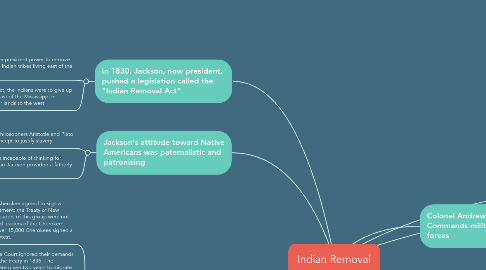Indian Removal
by Alejandro Perez

1. In 1830, Jackson, now president, pushed a legislation called the "Indian Removal Act"
1.1. This gave the president power to remove treaties with Indian tribes living east of the Mississippi
1.2. Under this act, the Indians were to give up their lands east of the Mississippi in exchange for lands to the west
2. Jackson's attitude toward Native Americans was paternalistic and patronizing
2.1. The Greek philosophers Aristotle and Plato gave this concept to justify slavery
2.2. Indians were incapable of thinking for themselves so Jackson provided a fatherly role....
3. For the next 28 years, the United States struggled to force the relocation of the Indian nations.
3.1. In 1833, the Cherokee agreed to sign a removal agreement: the Treaty of New Echota. The leaders of this group were not the recognized leaders of the Cherokee nation, and over 15,000 Cherokees signed a petition in protest.
3.2. The Supreme Court ignored their demands and ratified the treaty in 1836. The Cherokee were given two years to migrate voluntarily or be forcibly removed.
3.3. By 1838 only 2,000 had willingly left, 16,000 remained on their land. The U.S. government sent in 7,000 troops, who forced the Cherokees into stockades at bayonet point.
3.4. They were not allowed time to gather their belongings and as they left, whites looted their homes.
3.5. This began the march known as the Trail of Tears, in which 4,000 Cherokee people died of cold, hunger, and disease.
4. 4,000 of 18,000 Cherokee people died of cold, hunger, and disease because of Land
5. Colonel Andrew Jackson Commands military forces
5.1. Becomes Major General by the end of the War of 1812
5.2. Creeks and other native nation lose 22 million acres of land in Georgia, Alabama, and Louisiana
6. From 1812-1824, 11 treaties were made between the US and Native Americans
6.1. This divested land from Southern Indians
6.2. And gave them new lands out West
7. In 1823 the Supreme Court decided that Indians could only occupy lands within the United States, but could not hold title to those lands
7.1. Indians were not considered citizens of the United States
7.2. It wasn't until 1924 that Indians were given citizenship in the US
7.3. This is why they weren't able to hold title to those lands
8. The End


